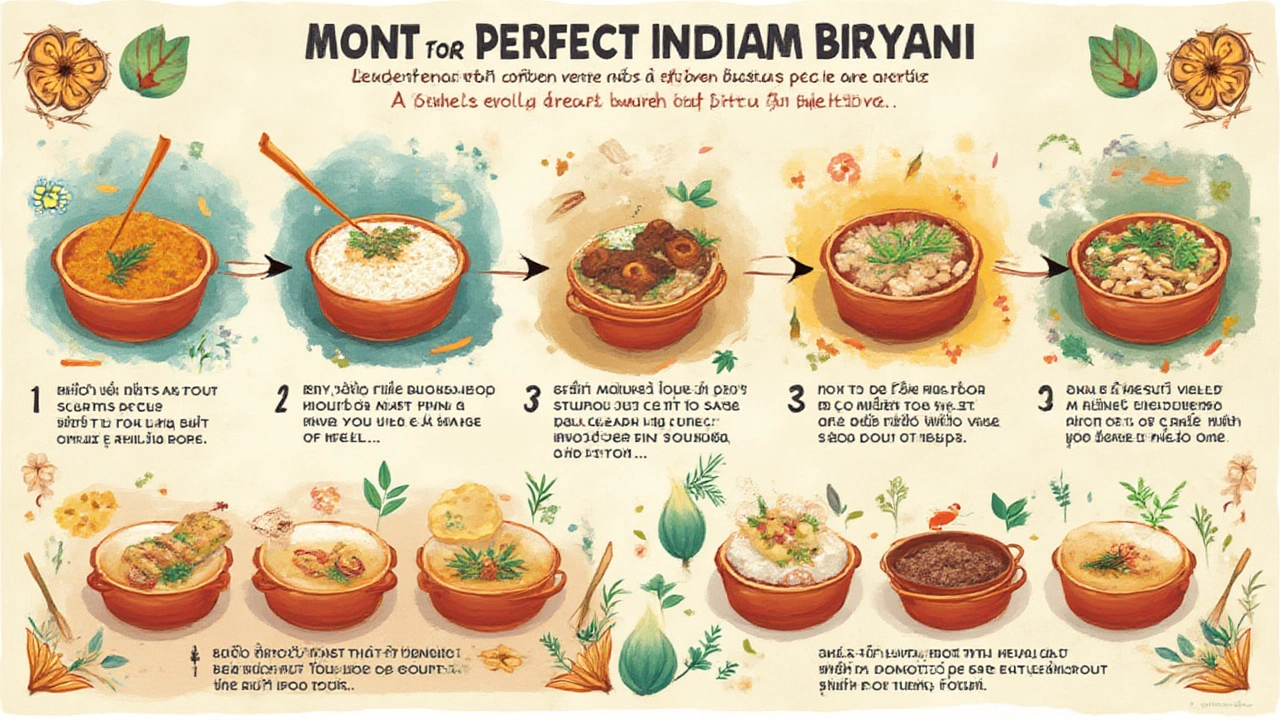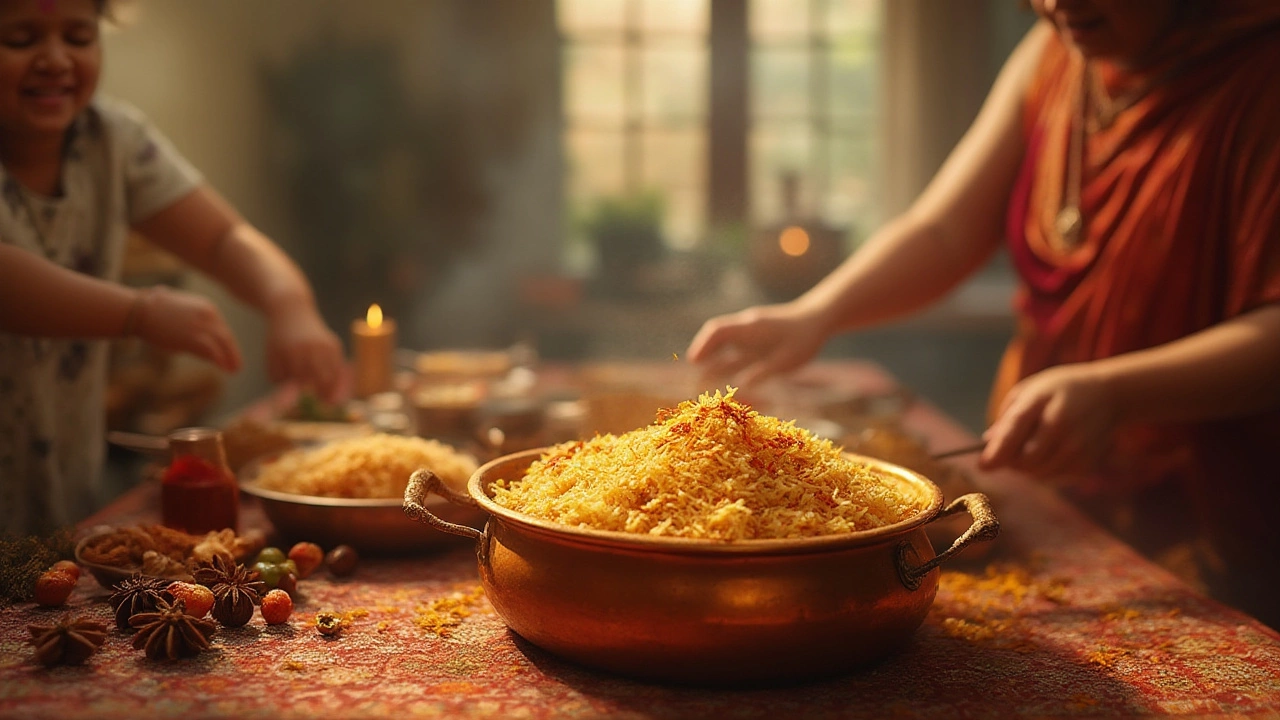24 Jul 2025
- 0 Comments
Ever seen people debate biryani with so much passion that you'd think it's a question of national importance? I get it. In my home, even my daughter Ivy has an opinion about the 'right' way to layer the rice, and she's only eight. There’s something magical about biryani. When it’s right, you can taste celebration in every bite. But when it’s off—even just by a little—it leaves you frustrated, cravings unsatisfied. So what actually makes the perfect biryani?
Every Grain Counts: Rice, Aroma & The Perfect Texture
Start with rice, because, honestly, it can make or break your biryani. Basmati is the uncontested hero here. Not any basmati—go for aged basmati. I remember my mother-in-law running her fingers through a sack at the store, checking for that faint nutty scent that only comes from properly aged grains. If you pour a cup of basmati rice into your palm, you want those grains slender and lengthened—not stubby. That’s your first hint of quality. Aged basmati cooks up fluffy and extra fragrant, each grain staying separate—no sticky, clumpy mess here.
Rinsing is non-negotiable. Wash the rice until the water runs almost clear, which pulls away excess starch. Soak it for twenty to thirty minutes. Don’t skip this part, unless you want rice that clings to itself (which, honestly, is just disappointing). When I’m short on time, even Ivy reminds me—"Don’t forget to soak the rice, Mom!" Boil the rice with whole spices: bay leaf, green cardamom, cloves, a cinnamon stick. These little things make your kitchen smell almost intoxicating. Did you know that boiling rice with spices infuses flavor without going overboard? It’s a quiet foundation. But be careful—only partially cook the rice (about 70% done), then stop. Overcooking means mushy disaster after the final steaming (what pros call 'dum').
There’s real science behind that aroma. A study from the Central Food Technological Research Institute in Mysore found that certain compounds in aged basmati (like 2-acetyl-1-pyrroline) give that signature nutty 'biryani scent.' If you’re reaching for 'just any rice'—don’t. It’s the difference between bland and irresistible.

The Heartbeat: Spice Blends, Marination & Meat Secrets
Biryani is all about layers—not just in the literal sense, but flavor-wise. The secret lies in two things: the spice blend and the meat (or vegetables, if you swing that way). Skip the bland stuff. A homemade blend always beats the store-bought masala. Most people swear by a balance of ground coriander, cumin, cardamom, cinnamon, nutmeg, cloves, and black pepper. It’s not about heat—it's about aromatics. Toast your spices gently for that warm, rich flavor before you even toss in anything else.
Now, about marination—this is where the meat (or paneer, jackfruit, soya) gets its chance to shine. If you’re making chicken biryani, use bone-in pieces. This keeps the meat juicy, and the bones soak in the flavors. For mutton lovers, patience is key: at least 6-8 hours marination for real tenderness. Common marinades use hung curd, ginger-garlic paste, green chillies, a good squeeze of lime, fresh coriander, and mint leaves. Everything melds overnight (or at least a few hours if you're impatient). I once made the rookie mistake of skipping fresh mint. Never again! It’s that fresh note in every mouthful. Some cooks even add a pinch of ground mace or star anise for complexity.
Your masala base should always have slow-cooked onions—really take your time here. Golden brown (not burnt) onions are called barista. These sweet yet earthy threads get layered, not mixed, so you hit that sweet-savory edge with every spoonful. Tomatoes, when used, must be peeled and chopped fine, then sautéed until the oil pools at the edges. Data from the National Institute of Nutrition in Hyderabad shows that sautéed onions actually boost the bioavailability of antioxidants in spices, making your biryani genuinely healthier as well.
Oil or ghee? You need both. Ghee brings depth and comfort, while oil (mustard or sunflower) prevents the biryani from feeling heavy. A lot of folks turn up their noses at too much oil, but this is one dish where a little more is just right. A few saffron threads (soaked in warm milk) add not just a gorgeous golden color but also a faint floral aroma. This is why festival biryanis just 'feel' special.

Layering Mastery and Dum Perfection: The Art of The Finish
Layering is where biryani turns from 'rice with curry' into something iconic. There’s an order: rice, masala/meat, rice, fried onions, fresh herbs, saffron milk, a drizzle of ghee—and repeat, depending on your pot's depth. Never stir the biryani after layering. Once you’ve done the work, let the flavors marry in peace. Pressing the layers too tight or mixing them makes biryani mushy. I learned this the hard way after mixing once in a rush—my mom banned me from biryani duty for months.
You want to seal the pot tightly. Traditionally, cooks used dough to seal the lid—so the biryani steams gently, capturing every bit of moisture and fragrance. You can fake this with foil, but dough really does work better. Turn the heat to low, and let it sit undisturbed for at least 25-30 minutes (if you’re making it for a crowd, a bit longer). This final step is 'dum,' and it’s everything. ‘Dum’ lets the flavors permeate without drying the rice or overcooking the meat. Some cooks put a tawa or griddle underneath their biryani pot for more even, gentle heat.
Serving biryani needs patience—don’t rush to fluff it. Use a flat spatula or a wide spoon, scoop from the sides, and gently lift those layers out, so you get rice, masala, and meat in a single serving. Sprinkle a bit of rose water (not too much!) or kewra water for that classic royal aroma—true biryani lovers will sniff approvingly. Here’s a little tip: always let the biryani sit, covered, for ten minutes after the dum step. This does wonders for texture.
Every region has a favorite style: Hyderabadi is all about the 'kacchi' (raw marinated) technique where raw marinated meat is layered with partially cooked rice. Kolkata’s biryani is famously fragrant, lighter on spice, and has—you guessed it—a chunk of potato (thanks to Nawab Wajid Ali Shah bringing it over in exile). Some add boiled eggs and dried plums for subtle sweetness. But don’t let tradition box you in. I’ve met grandmothers in Lucknow who splurge on smoked ghee, charcoal dum, or even a touch of vetiver essence to set their biryani apart.
Want to avoid rookie mistakes? Keep this checklist handy:
- Don’t overcook your rice—aim for al dente.
- Give your marination time.
- Be generous (but not reckless) with oil and ghee.
- Seal your pot well for the dum process.
- Never mix the layers after dum—fluff gently if you must.
Your senses will tell you if you’ve got it right: The steam that escapes when you first unseal the pot, the golden strands of saffron rice, the aroma of spices, and the plump, flavorful bits of meat. Here’s what a simple biryani data table might look like for foolproof proportions:
| Ingredient | Standard Household Portion (Serves 4) |
|---|---|
| Basmati Rice | 2 cups (400g) |
| Chicken/Mutton | 500g |
| Onions (sliced) | 3 medium |
| Hung curd | 1/2 cup |
| Saffron | 15 strands (soaked in 2 tbsp warm milk) |
| Fresh herbs (mint+coriander) | 1 cup total (chopped) |
| Whole spices (cardamom, clove, etc.) | 2 each |
| Oil | 3 tbsp |
| Ghee | 2 tbsp |
| Marination time | 6 hours (mutton), 2 hours (chicken) |
Here’s the truth: No one can agree on the 'best' biryani, but that’s kind of the point. What matters is balance. When each component—rice, masala, meat, herbs—works together but still shines on its own, you know you’ve nailed the perfect biryani.
